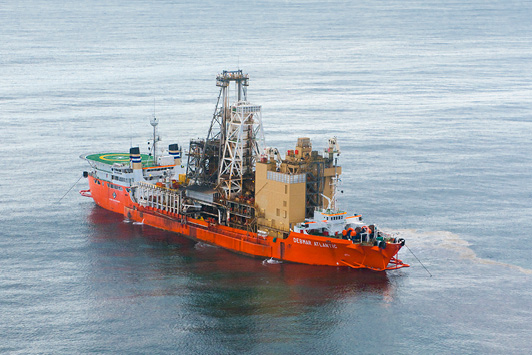
The town of Oranjemund, which sits at the mouth of the Oranje River near the South African border, has long been a center of Namibia’s diamond mining industry. In October, Namibia lifted restrictions on visitors — who previously needed police clearance to enter the town — for the first time since 1936, and Namdeb, the government’s joint mining venture with De Beers, has since handed over Oranjemund’s administration to a local authority that plans to promote tourism as the mainstay of the town.
This development is one of the clearest signs that land-based diamond production in the country is on the decline. In fact, such mining operations are poised to stop in a few years as the focus moves to the Atlantic Ocean, where diamonds are being recovered from the seabed.
Cornerstone of the economyDiamonds are Namibia’s most lucrative export. Under the sales agreement the government signed with De Beers in May 2016, it was announced that Namibia would see a significant increase in rough diamonds remaining in the country for supply to local companies, with $430 million of rough diamonds offered annually through the Namibia Diamond Trading Company (NDTC) — another joint venture between De Beers and the government.
The targets of that agreement are being achieved, according to Paul Rowley, executive vice president at De Beers Global Sightholder Sales and a member of the NDTC. Local factories are receiving rough diamonds, including big stones, he says. “We supply [diamonds] with the understanding that the majority of them should be manufactured here.”
Mines washing outBut where those diamonds will come from is gradually changing. Diamond production from marine resources overtook land production for the first time in 2005, yielding 922,000 carats, according to Stella Auala, the spokesperson for offshore mining company Debmarine Namibia. The following year, the company — of which De Beers and the government each own half — achieved an output of 1 million carats for the first time, “which it consistently produces since then,” she says.
In 2016, when De Beers’ production in the country reached nearly 1.6 million carats, the majority of those were marine diamonds; land-based mining accounted for only 403,000 carats, according to an annual report by the Chamber of Mines of Namibia for that year.
Following that trend, a report by the Mineworkers Union of Namibia this past October predicted that mining on land would cease in another five years. The union said Namdeb had informed its members that the Elizabeth Bay mine would close at the end of 2018, the Daberas deposit at the end of 2019, the Sendelingsdrift site in 2020, and the main mine, Southern Coastal, in 2022.
Setting sail for better prospectsMeanwhile, Debmarine — which has a mining license for the Atlantic Ocean that’s valid until 2035, according to Auala — has already started expanding its fleet for increased production at sea. In June, the company launched a new ship, the
mv SS Nujoma, which cost $157 million to build. The deep-water diamond exploration and sampling vessel was constructed in Norway by the Kleven Verft shipbuilding group. On November 21, Debmarine announced plans to build a new ship that would commence operations in the third quarter of 2021. Kleven Verft will build this one as well, increasing Debmarine’s fleet to six mining vessels.
With so much invested in its diamond industry, Namibia needs to ensure it can keep producing enough of these stones to supply its factories and sustain its economy. And as it has already recognized, the sea is a promising resource for fulfilling this need.
Image: De BeersArticle from the Rapaport Magazine - January 2018. To subscribe click here.